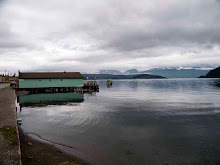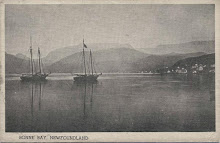It is finished, well almost there is still a bit of sewing to do. I have finally come to terms with the official snaps that I made toting the Deardorff and the Hobo around Bonne Bay in 2005. The first of the books is made 51 images – 3 haikus. I have two more already going but what six months ago was work that seemed endless – I was having problems editing the mass of negs, printing them to the point I never had the chance to sequence them - now is not only manageable but quite straight forward.
It is all due to giving up my 19th century ways.
When I was on the residency, it was great coming back to the house every evening developing the film and then printing them having rushes sent over to the Discovery Centre and for a time back down here it worked also, it was slow going but I was making progress to the point that I made three trial books of excerpts and while the task looked daunting, I was pleased with the progress. Slow photography movement.
Then something went awry, I couldn’t make a decent platinotype, the skies on the paper were splotchy, but only on the paper I had chosen, switched papers and it wouldn’t lie flat enough to give me a straight edge. Even though I knew that it would lead to failure I tried over and over again wasting materials and money.
Scanning for the show at James Baird >Pouch Cove and seeing the quality of the images that were made, had me twig that if I can get 100x90cm images, I could scan and have excellent 35x17cm ones.
Also because I had to come up with a variation on black and white printing for class in a lab that wasn’t up, I discovered, a rip programme – that I found out later real photography departments already know about – in which I could subtly change the tones of my pigmented archival prints.
Two days scanning a week tweaking another printing and am done – well almost.
This is not to make it sound easy and to fall into that digital cure all trap, the reason the time is so truncated is due to the fact that I could work on them longer during the day and print non stop.
I can – and have heard the howls of derision when I mentioned that while they are not – and I repeat not – platinotypes they work well with my initial idea.
I can hear sharp intakes of breath as people reconcile this with my perceived luddite status.
My initial idea was not to make platinotypes not even to make images where a darkroom wouldn’t be needed but to make a book of the work done while with Parks Canada. I still have the choice of paper that I wanted, I can control the tones better and more subtly and if I did this initially I wouldn’t have had to “spot” the negs in Photoshop to clean up the stains from what was still damp coated paper.
I’d still be in the first phase.
Am I giving up on platinotypes and their ilk? No, I still like the craft and when exact tonal replication from print to print in a series isn’t necessary like the variations.
Do I regret giving up my slow photographer status? Not sure that I have as it takes as long for a print to be churned out the Epson as it does to be exposed, freeing me for other things, and I don’t check my e-mail when printing. The cost of an archival pigmented print is about the same as a platinotype – inkjet paper is expensive.
How would I equip the house on the rock? the way I always said I would. Film for making the negs but scanners and printers for making the snaps.
Cannot wait to tackle book two after Yanksgiving.
Science and Art
-
The teaching of the sciences and the arts needs to be conjoined and
sustained from the earliest stages of education. In the Foreward to
Platinotype my frie...
2 years ago






No comments:
Post a Comment